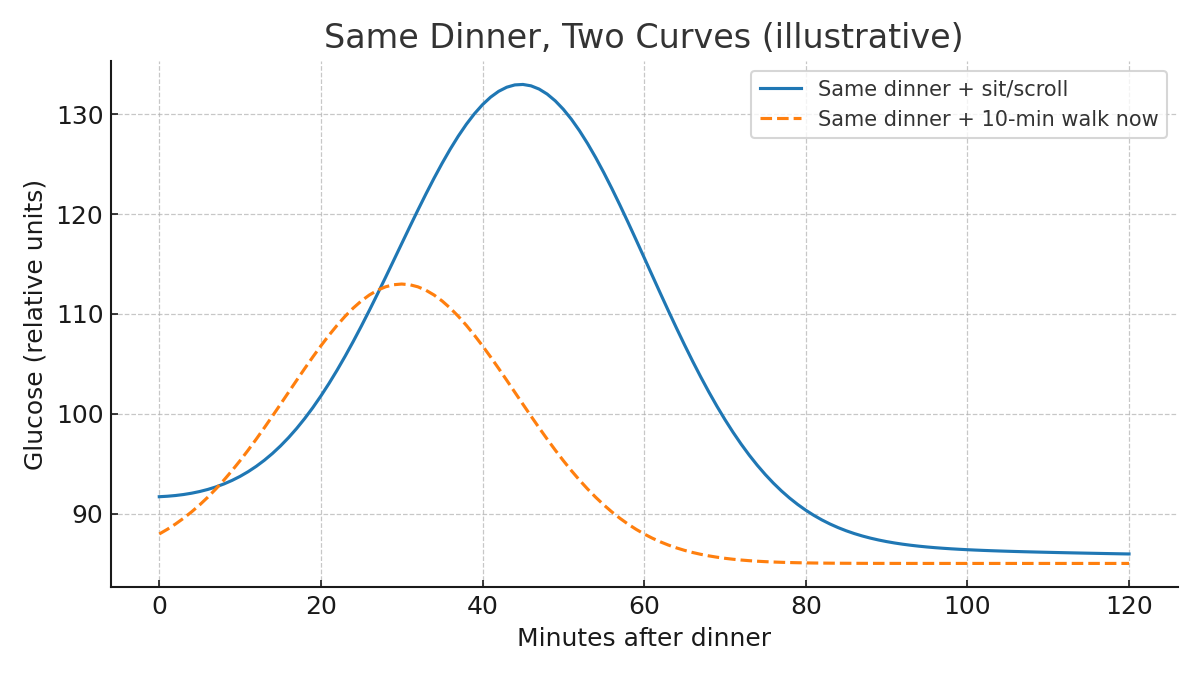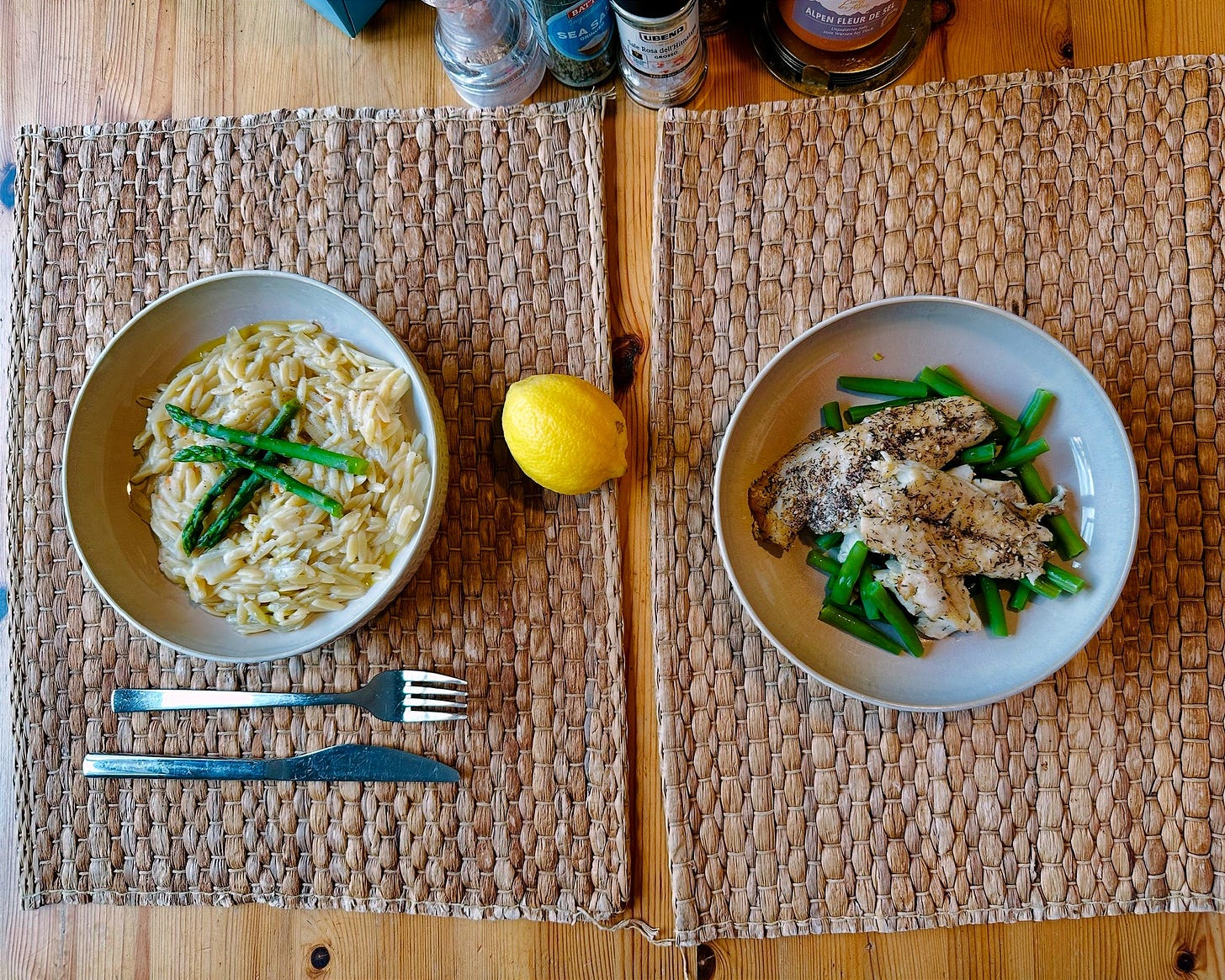Dinner, Walk, Repeat: How a 10-minute post-meal walk flattens your glucose curve and protects long-term insulin sensitivity
The low-friction ritual your metabolism has been waiting for.

1. Pan to walk: the 10-minute hack that beat my gadgets
Orzo with fish and greens shouldn’t count as a biohack, but last week it beat my gadgets. If you read my previous article, you'll remember that the people we interact with regulate our physiology. Think cortisol, blood glucose, hormonal balance, and more.
Add another habit to that, a 10 minutes of movement right after dinner [1][2], and the effect cascades. (I often go for 30-minute walks or longer; ten is enough to do the trick on your glucose curve, though.)
The next morning, my Oura app confirms it: HRV +15 ms. Time-to-sleep –43%. Energy steadier.
No magic involved here, just timing and predictable results of a simple physiological principle.
Stand within five minutes. Move for ten.
2. Your muscles are a glucose vacuum
Blood glucose rises after you eat.
Contracting big muscles immediately—quads, calves, glutes acts like a glucose vacuum, pulling sugar into cells before insulin finishes knocking.
That flattens the peak and cuts the body’s insulin spend. Do that often, and you protect insulin sensitivity over time.
Add people you enjoy spending time with in the loop, and you nudge the rest-and-digest (parasympathetic nervous system); your body reads safe.
Because connection before correction leaves fingerprints on physiology.
Translation: calmer curve, calmer you.
To put this to the test in creative ways, I bundled my favourite post-dinner rituals into the Stand, Move, Connect — The 5-Minute Cheatsheet to a Better Glucose Curve. Seven after-dinner rituals, zero gadgets.
Download it, try the rituals and let me know: Dinner + ten =? Tag me @anastate with what changed.
3. Same dinner, two curves: the data doesn't lie
Tuesday: Fish, orzo, greens and a 10-minute walk while the bowls were still warm.
Thursday: same meal, sat and scrolled.
The research echoes this.
A recent randomised crossover study [1] found that a 10-minute walk immediately after eating lowered the glucose peak more than sitting, while a longer walk done later didn’t move the needle as much.
Reviews line up: the sooner you move, the better the spike behaves; small bouts add up [2][3]. Classic trial? 3 × 15 minutes after meals, beat 1 × 45 for all-day control [3].
Lower peaks → less insulin spent to do the same job → better sensitivity over time, easier sleep.
So, copy Tuesday. Move while the pot’s still steaming and your muscles vacuum glucose; wait an hour, and you’re mopping after the spill [3].
Rain? Stairs. Tiny flat? Living-room loops. The rule is the same: plates down, muscles on.
4. Keep the menu, change the timing
Here’s how you can make dinner work for you without even changing the menu:
Before you eat:
Start with protein and greens (fibre first)
Add a squeeze of lemon and a drizzle of olive oil (both act as a buffer)
Let your carbs play a supporting role, not lead actors (I know you love sourdough bread as much as I do).
Keep some bite to your veg when you cook them; that satisfying crunch isn't just for show, it keeps your glucose in check.
While you eat:
Chew like you mean it; it signals your stomach to slow down, smoothing out the glucose rise.
Put your fork down between bites.
Plates down, muscles on
Stand within 5 minutes of your last bite.
For 10 minutes: dance, do the dishes, go round the block, up and down the stairs, or walk your neighbour's dog (I bet she’ll be happy).
What you’ll notice: a flatter curve, less 10 p.m. static, fewer cupboard raids.
And if a snack taps your shoulder, answer it with protein + fibre and call it a night. (Greek yoghurt plus chia seeds, nuts, etc)
Let’s now put these suggestions to work with a beautiful, simple recipe.
Cook this: summer orzo with fish & greens.
This recipe should have been a risotto, but I ended up cooking orzo instead. It’s easy to cook because it uses leftovers and greens you probably have in the fridge or freezer already.
Serves: 2
Prep time: 10 mins
Cooking time: 25 mins
Ingredients:
2 medium bream fillets per portion
250g mixed greens (asparagus, green beans work great)
140g orzo
25g Parmesan (or rind from Parmigiano Reggiano)
1 garlic clove
1 small shallot
1 tsp ghee
Juice of half a lemon
1-2 tsp herb mix (Italian, Provençal, whatever you have)
Salt and pepper
Method:
Wash and trim your greens. Pat fish dry, season with salt, pepper, and herbs.
Dice shallot and garlic.
Sauté shallot and garlic in ghee over medium heat until translucent.
Add orzo, stir. Add 400ml water/broth (2:1 ratio) and parmesan rind. Cook per package instructions, stirring continuously.
While orzo cooks, pan-fry the fish (6 minutes), steam the asparagus (3-5 minutes), and steam the greens (5-7 minutes).
Rest greens 2 minutes, then drizzle with olive oil and lemon juice. Season.
Chop fresh parsley and add to finished orzo.
Plate in this order: Vegetables first, fish on top, orzo last. Extra parmesan on top.
All’s left to do is enjoy!
As always, thank you for reading Salt, Pepper, Stories. If this post helped you, give it a heart, comment, or share it with someone who needs a big hug and delicious food.
Be well, eat well, walk ten.
x, Ana
Footnotes
[1] Hashimoto K, Dora K, Murakami Y, et al. (2025). Positive impact of a 10-min walk immediately after glucose intake on postprandial glucose levels. Scientific Reports. Randomized crossover: a 10-min walk immediately after ingestion lowered peak glucose vs control; a 30-min walk later did not reach significance. (Open access.) NaturePMC
[2] Engeroff T, et al. (2023). After Dinner Rest a While, After Supper Walk a Mile?—A Systematic Review… Sports Medicine – Open. Conclusion: post-meal exercise has a greater acute effect on postprandial glucose when undertaken as soon as possible after eating; delaying weakens the effect. (Open access.) PMC
[3] Bellini A, et al. (2024). Exercise Prescription for Postprandial Glycemic Management. Practical guidance review summarizing trials: brief, light-to-moderate activity in the immediate post-prandial window blunts excursions; small bouts accumulate. (Open access.) PMC
[4] DiPietro L, et al. (2013). Three 15-min bouts of moderate postmeal walking significantly improve 24-h glycemic control in older people at risk for impaired glucose tolerance. Diabetes Care. 3×15-min after meals outperformed 1×45-min for 24-h control. (PubMed + full text.) PubMedPMC
[5] Moore JM, et al. (2024). One minute of stair climbing/descending reduces postprandial glucose and insulin; ≥3 minutes improves insulin resistance indices. Brief “micro-dose” movement after a mixed meal produced measurable benefits. (PubMed.) PubMed
[6] Yao J, et al. (2024). Diet, physical activity, and sleep in relation to postprandial glycemia. IJBNPA. Synthesis suggests feasible post-meal brisk walking meaningfully improves glucose control in free-living settings. BioMed Central
Nuance / special population
[7] Christie HE, et al. (2024). Diagnosis to Delivery: A Randomized Clinical Trial of Postmeal Walking in Women with Gestational Diabetes. Med. & Sci. in Sports & Exercise. 3×10-min post-meal walks did not outperform standard care in this group; intensity/dose may need tailoring during pregnancy. (PubMed.) PubMed





